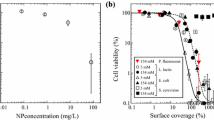Abstract
The ozone impact on Pseudomonas aeruginosa ATCC27853 cells was studied. Ozone-induced loss of K+, Mg2+, and ATP was measured using inductively coupled plasma/mass spectrometry and a bioluminescence assay. Maximum releases of K+ and Mg2+ were achieved at 0.37 mg/L of ozone after 2 min with a killing rate of culturable bacteria greater than 93%. Maximum release of ATP was attained at 0.42 mg/L of ozone after 3 min. Transmission electron microscopy showed that shapes of treated cells were integrated, but cytoplasmic agglutinations and vacuoles appeared. Ozone treatment caused lysis of P. aeruginosa cells to be sensitive to sodium dodecyl sulfate, insensitive to NaOH, and subject to inactivation by proteinase K. A combined action of cytoplasm agglutination, protein denaturation, and membrane permeabilization, rather than cell lysis, leads to non-culturability of P. aeruginosa cells.
Similar content being viewed by others
References
Silva ME, Filho IC, Endo EH, Nakamura CV, Ueda-Nakamura T, Filho BP. Characterisation of potential virulence markers in Pseudomonas aeruginosa isolated from drinking water. Anton. Leeuw. 93: 323–334 (2008)
Rusin PA, Rose JB, Haas CN, Gerba CP. Risk assessment of opportunistic bacterial pathogens in drinking water. Rev. Environ. Contam. T. 152: 57–83 (1997)
Zhang YQ, Wu QP, Peng FT, Zhang JM, Guo WP, Yang XH. Contamination of Pseudomonas aeruginosa and bromate in mineral water. J. Food Sci. Biotechnol. 31: 1046–1047 (2012)
Komanapalli IR, Lau BHS. Ozone-induced damage of Escherichia coli K-12. Appl. Microbiol. Biot. 46: 610–614 (1996)
Cho M, Kim J, Kim JY, Yoon J, Kim JH. Mechanisms of Escherichia coli inactivation by several disinfectants. Water Res. 44: 3410–3418 (2010)
Cortezzo DE, Koziol-Dube K, Setlow B, Setlow P. Treatment with oxidizing agents damages the inner membrane of spores of Bacillus subtilis and sensitizes spores to subsequent stress. J. Appl. Microbiol. 97: 838–852 (2004)
Young SB, Setlow P. Mechanisms of Bacillus subtilis spore resistance to and killing by aqueous ozone. J. Appl. Microbiol. 96: 1133–1142 (2004)
Yeaman MR, Bayer AS, Koo SP, Foss W, Sullam PM. Platelet microbicidal proteins and neutrophil defensin disrupt the Staphylococcus aureus cytoplasmic membrane by distinct mechanisms of action. J. Clin. Invest. 101: 178–187 (1998)
Johnston MD, Hanlon GW, Denyer SP, Lambert RJM. Membrane damage to bacteria caused by single and combined biocides. J. Appl. Microbiol. 94: 1015–1023 (2003)
Zuma FN, Lin J, Jonnalagadda SB. Kinetics of inactivation of Pseudomonas aeruginosa in aqueous solutions by ozone aeration. J. Environ. Sci. Heal. A. 44: 929–935 (2009)
Zhang YQ, Wu QP, Zhang JM, Yang XH. Effects of ozone on membrane permeability and ultrastructure in Pseudomonas aeruginosa. J. Appl. Microbiol. 111: 1006–1015 (2011)
Chen AM, Shi QS, Feng J, Ou-Yang YS, Chen YB, Tan SZ. Dissociation of outer membrane for Escherichia coli cell caused by cerium nitrate. J. Rare Earth. 28: 312–315 (2010)
Ayres H, Furr JR, Russell AD. A rapid method of evaluating permeabilizing activity against Pseudomonas aeruginosa. Lett. Appl. Microbiol. 17: 149–151 (1993)
Munton TJ, Russell AD. Effects of glutaraldehyde on the outer layer of Escherichia coli. J. Appl. Bacteriol. 35: 193–199 (1972)
Russell AD, Vernon GN. Inhibition by glutaraldehyde of lysostaphin-induced lysis of Staphylococcus aureus. Microbios 13: 147–149 (1975)
Walsh SE, Maillard JY, Simons C, Russell AD. Studies on the mechanisims of the antibacterial action of ortho-phthalaldehyde. J. Appl. Microbiol. 87: 702–710 (1999)
Wei MK. Studies on the mechanisms of cellular damages on microbes by chlorine dioxide. PhD thesis, South PR China Sea Institute of Oceanology, Chinese Academy of Sciences, Guang Zhou, Guangdong, China (2008)
Mehlman MA, Borek C. Toxicity and biochemical mechanisms of ozone. Environ. Res. 42: 36–53 (1987)
Hinze H, Prakash D, Holzer H. Effect of ozone on ATP, cytosolic enzymes and permeability of Saccharomyces cerevisiae. Arch. Microbiol. 147: 105–108 (1987)
Takamoto Y, Maeba H, Kamimura M. Changes in survival rate enzyme activities and in Escherichia coli with ozone. Appl. Microbiol. Biot. 37: 393–395 (1992)
Author information
Authors and Affiliations
Corresponding author
Rights and permissions
About this article
Cite this article
Zhang, Yq., Wu, Qp., Zhang, Jm. et al. Effects of ozone on the cytomembrane and ultrastructure of Pseudomonas aeruginosa . Food Sci Biotechnol 24, 987–993 (2015). https://doi.org/10.1007/s10068-015-0126-8
Received:
Revised:
Accepted:
Published:
Issue Date:
DOI: https://doi.org/10.1007/s10068-015-0126-8




